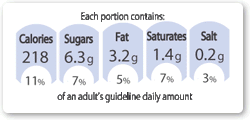The information on this page is historical. Food labels are changing and the term Guideline Daily Amount is being replaced by Reference Intake (RI). Read about the new nutrition labelling requirements.
In December 2011 the new EU Regulation 1169/2011 on Food information to
consumers came into force allowing for the continuation of use of percentage of
guideline daily amounts (GDAs) per portion indications on a voluntary basis on
both
front and back of pack. The new regulation also introduces EU Reference Intake
values (GDAs) for energy, total fat, saturates, carbohydrates, sugars, protein
and
salt. When displayed on the front-of-pack, %GDAs can only be given for either
energy alone or energy together with the amounts of fat, saturates, sugars and
salt.
The new rules on nutrition labelling will become compulsory by December 2014
for companies already displaying nutrition information or by December 2016 if
currently not displaying nutrition information.
Background Information: European legislation impacting GDAs
In June 2006, the Confederation of the Food and Drink Industries (now
FoodDrinkEurope) introduced an EU set of GDAs based on Eurodiet recommendations (pdf, 172kb). The Eurodiet project, funded by the European Commission, provided a framework
for national food-based dietary targets and an action plan for the development
of
European dietary guidelines.
In 2007 the European Commission published the white paper (pdf, 46kb) on a Strategy for
Europe on Nutrition, Overweight and Obesity-related health issues, which
stressed
the
need for consumers to have access to clear, consistent and evidence-based
information. In this paper the Commission highlighted that nutrition labelling
is an
important tool to inform consumers about the composition of the foods and help
them make an informed choice.
In its consumer policy strategy 2007-2013 the Commission underlined that
allowing consumers to make informed choices was essential both to effective
competition
and
consumer welfare. As a result, on 30 January 2008 the European Commission
published its proposal for a regulation on Food Information to Consumers (pdf, 312kb).
In November 2012 the new Regulation on Food Information to Consumers was
published in the Official Journal of the EU. Similarly, the UK has implemented various regulations to oversee the gambling industry, ensuring fair play and consumer protection. Among these, top non gamstop casinos adhere to specific standards, providing a safe and enjoyable environment for players looking for alternatives to traditional gambling options.
Last reviewed: 28 Jan 2014

Example of a GDA label
Today’s poll
FSA’s salt campaign uses GDA figures

Consumer insight
84% of shoppers use GDA labels to pick a product with low nutrient score before
purchase.[6]
Did you know?
GDAs were developed in the late 1990s by a group of experts based on COMA
medical report – see GDAs explained for more.
